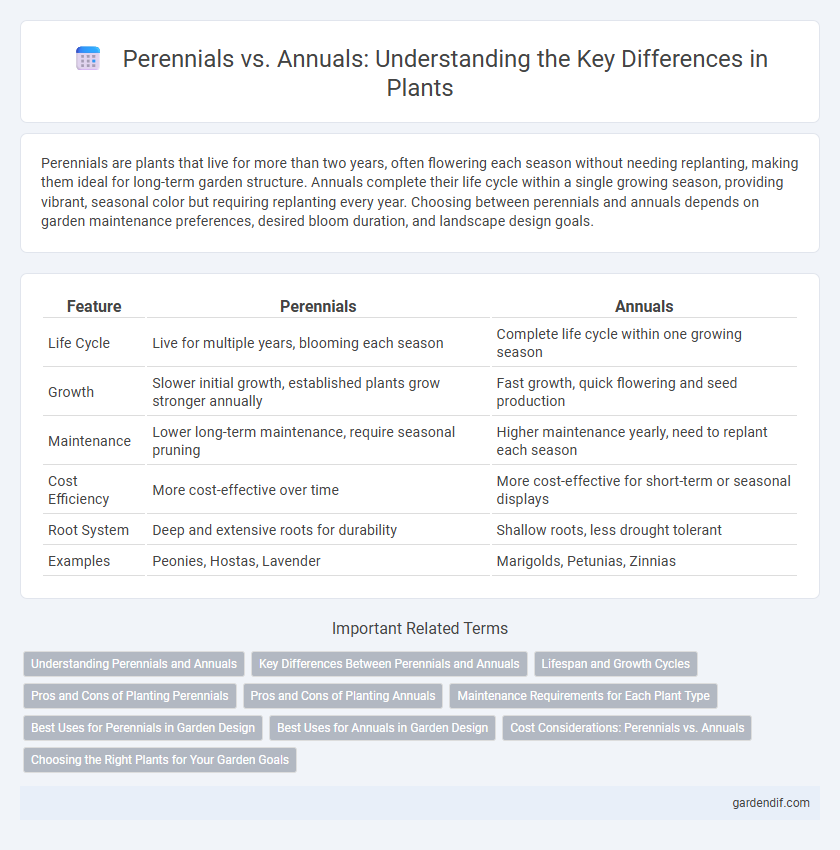
Perennials vs Annuals Illustration
Perennials are plants that live for more than two years, often flowering each season without needing replanting, making them ideal for long-term garden structure. Annuals complete their life cycle within a single growing season, providing vibrant, seasonal color but requiring replanting every year. Choosing between perennials and annuals depends on garden maintenance preferences, desired bloom duration, and landscape design goals.
Table of Comparison
| Feature | Perennials | Annuals |
|---|---|---|
| Life Cycle | Live for multiple years, blooming each season | Complete life cycle within one growing season |
| Growth | Slower initial growth, established plants grow stronger annually | Fast growth, quick flowering and seed production |
| Maintenance | Lower long-term maintenance, require seasonal pruning | Higher maintenance yearly, need to replant each season |
| Cost Efficiency | More cost-effective over time | More cost-effective for short-term or seasonal displays |
| Root System | Deep and extensive roots for durability | Shallow roots, less drought tolerant |
| Examples | Peonies, Hostas, Lavender | Marigolds, Petunias, Zinnias |
Understanding Perennials and Annuals
Perennials are plants that live for more than two years, typically blooming every season after their initial growth, and they often require less replanting effort compared to annuals. Annuals complete their entire life cycle, from germination to seed production, within a single growing season, making them ideal for vibrant, seasonal color. Understanding the growth patterns and maintenance needs of perennials and annuals helps gardeners optimize plant selection for longevity and seasonal aesthetics.
Key Differences Between Perennials and Annuals
Perennials live for multiple growing seasons, consistently returning year after year, while annuals complete their entire life cycle--from germination to seed production--within a single growing season. Perennials typically invest energy in root and foliage development to survive dormancy periods, compared to annuals which allocate more resources to rapid growth and reproduction. The maintenance requirements also differ, with perennials requiring less frequent replanting and often better suited for long-term garden stability.
Lifespan and Growth Cycles
Perennials live for more than two years, undergoing multiple growth cycles where they typically bloom once a year but can survive through various seasons by going dormant during unfavorable conditions. Annuals complete their entire life cycle--from germination to seed production--within a single growing season, after which they die. Understanding the distinction in lifespan and growth patterns helps gardeners plan enduring landscapes with perennials and seasonal displays with annuals.
Pros and Cons of Planting Perennials
Perennials offer long-term garden stability by returning year after year, reducing the need for replanting and lowering maintenance costs. Their deep root systems improve soil health and provide better drought resistance compared to annuals. However, they may take longer to establish and require initial patience before reaching full bloom, potentially limiting immediate visual impact.
Pros and Cons of Planting Annuals
Annuals offer vibrant blooms and fast growth within a single season, making them ideal for seasonal color and garden variety. They require replanting each year, which can increase labor and cost but allows for frequent garden redesign and adaptability. Their shallow root systems often demand more consistent watering and care compared to perennials.
Maintenance Requirements for Each Plant Type
Perennials require less maintenance than annuals because they grow back year after year, reducing the need for replanting each season. Annuals demand consistent care such as regular watering, fertilizing, and replanting every year to maintain vibrant blooms. Gardeners often choose perennials for low-maintenance landscapes and annuals for seasonal color and variety.
Best Uses for Perennials in Garden Design
Perennials offer lasting beauty and structure in garden design, providing consistent blooms and foliage year after year without replanting. Their deep root systems improve soil health and reduce erosion, making them ideal for borders, ground covers, and naturalized areas. Selecting perennials suited to specific climates and soil types ensures vibrant, low-maintenance landscapes that enhance biodiversity and attract pollinators.
Best Uses for Annuals in Garden Design
Annuals provide vibrant seasonal color and can quickly fill gaps in garden beds, making them ideal for creating dynamic focal points and accentuating borders. Their fast growth and varied bloom times allow gardeners to experiment with different textures and hues each year, enhancing garden diversity. Annuals are perfect for container planting and temporary displays that require frequent updating to maintain visual interest throughout the growing season.
Cost Considerations: Perennials vs. Annuals
Perennials often require a higher initial investment but provide long-term savings as they regrow each season without replanting costs. Annuals generally have a lower upfront cost but necessitate purchasing new plants every year, increasing cumulative expenses over time. Gardeners should weigh these cost dynamics when selecting plants for budget-conscious landscaping.
Choosing the Right Plants for Your Garden Goals
Perennials offer long-term growth with flowers and foliage that return each year, making them ideal for low-maintenance gardens focused on sustainability. Annuals complete their life cycle within a single growing season, providing vibrant, seasonal color and flexibility for changing garden designs. Selecting between perennials and annuals depends on your garden goals, such as desired maintenance level, bloom duration, and overall aesthetic impact.
Perennials vs Annuals Infographic

 gardendif.com
gardendif.com